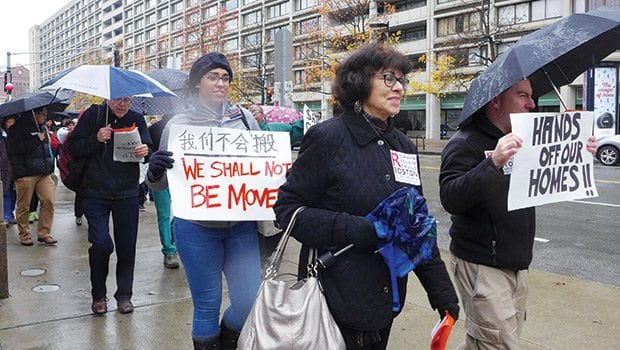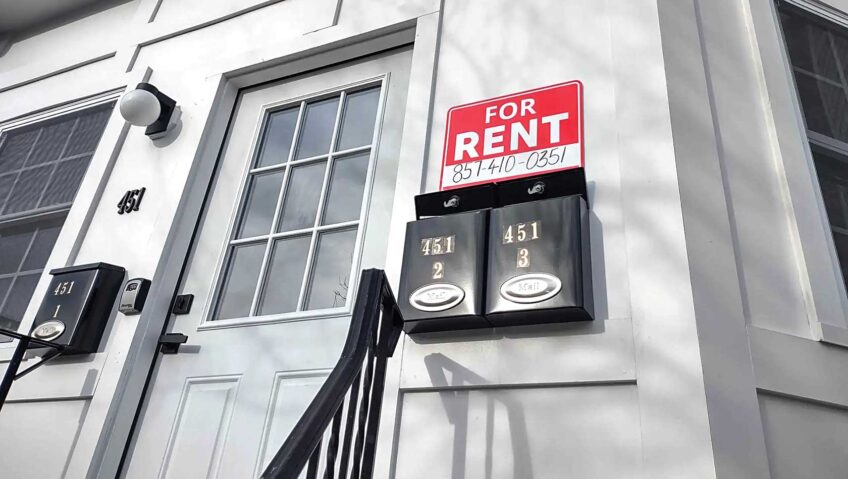Fenway fights to keep affordability
City faces risk of economic segregation

In the latest manifestation of Boston’s housing crisis, residents and activists marched last week from Clearway St. to Berklee College of Music’s building on 1140 Boylston St. to protest what they say could be the loss of the last non-subsidized affordable housing in the Fenway neighborhood.
The battleground: Housing on Clearway St.
“The Fenway is again at a crisis point,” said a press release issued by Right to the City Boston. “Apartments on Clearway Street were some of the last lower-cost units left.”
No new affordable units have been built in the Fenway/Back Bay area in the past decade, said Richard Giordano director of community organizing for Fenway Community Development Corporation.
Earlier this year, approximately 100 long-term residents either were not given the option to renew their leases or, in the case of at-will tenants, received a 30-day notice, said members of Fenway CDC and other protestors.
The units were then leased to Berklee College of Music students for rents of $1,000 more per month.
Protestors also decried an agreement between the college and the property owners and managers to reserve space and facilitate leases for the students. Previously, Berklee administration sought to take out its own lease on the units, a request the city rejected. Activists charge the new arrangement achieves the same effect by turning many of the rooms into dorms.
Clearway squeeze-out
Two-bedroom apartments on Clearway St went for $2,060-$2,600 a month in 2014, Giordano said, referring to a sampling of ten rental listings.
In comparison, entering students moved in four to a two-bedroom unit for rents of $900 per person, netting a total $3,600 per unit rent, according Leah Camhi, executive director of Fenway CDC, and Louvere Walker, board president of Fenway CDC.
Those who were still offered a chance to renew leases may be affected as well.
With two-bedrooms fetching high rents from students, rents likely will rise on the larger units, said John, a resident who lives a few streets away on Hemenway St and asked to be identified only by his first name.
Additionally, Giordano predicted that once other landlords see these high apartment prices, they will seek to cash in as well.
“It brings up the floor everywhere else, and the next landowner does the same thing. They’ll say ‘Why should I rent to [these] people when I can get $1,600 more a month by putting students in the place?’”
The costs of displacement
As housing prices soar across the city, low- and moderate-income residents struggle to afford rents in the neighborhoods they grew up in. There are 35,000 Bostonians spending more than half their income in rent, according to a Right to the City press release. From 2006 to 2013, the number of people in this situation rose by six percent, reported New York University’s Furman Center for Real Estate and Urban Policy and Capital One.
Not only is keeping up with rent payments difficult, but once displaced, a resident may be challenged to find any place in the city that they can afford. In 2013, the median rent paid by tenants who moved into a unit within the last five years was 70 percent higher than the median rent paid by tenants who had lived in the same unit for five or more years, according to the Furman Center/Capital One report.
“This suggests that renters who have lived in place for a while will likely struggle to find a similarly affordable unit if they have to move,” the report states.
In some cases, residents displaced from Clearway are living an hour away, but still commuting to the same local jobs, John said.
“Now you will have the people who work in the stores here not able to live here,” he said.
Economic segregation
Affordability activists said Boston risks becoming economically segregated.
Much of downtown could become home only to the wealthy, while current residents are forced out, Giordano said.
“If the prices keep doing what they’re doing, they’re only going to have wealthy elites living in downtown.”
Under the current housing boom, prices have been rising on existing units and many newly-constructed buildings cater to the wealthy.
Lower-income people may be pushed out of much of the city and the economic and social resources it offers, said Mark Liu, program operations director for the Chinese Progressive Association.
“Fenway, like Chinatown, is a high-opportunity district. It’s in the middle of a lot of job opportunities and transportation,” Liu said.
“We want to make sure poor people have the right to live where they need and want and that it’s not just based on cycles of where’s trendy at the time.”
Last week’s marchers included members of several neighborhoods, including Chinatown, who are concerned about diminishing affordability in their communities.
Giordano said that successfully maintaining the housing at Clearway — protestors ask that students leave once their leases end and no new students enter — would help similar fights in other neighborhoods.
“If we’re successful, then that’s going to help all the neighborhoods in the city to reverse some of this trend. This could mean that we stop institutional expansion in the form of universities,” he said. “It will make it harder for institutions to bulk-refer students to a landlord, especially if the landlord has existing tenants.”






